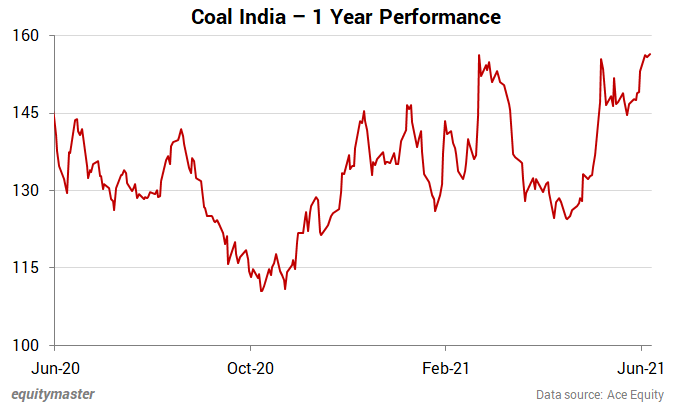

Shares of Coal India hit a 52-week high of Rs 164.5 per share amid expectations of improvement in earnings.
The PSU stock surpassed its previous high of Rs 163, touched on 26 February 2021.
In the past two weeks, the stock has outperformed the market by gaining 12% compared to a 2.2% rise in the BSE Sensex.
A sharp rally in the stock price has helped Coal India regain the market capitalisation of Rs 1 tn.
Coal India reported a strong offtake in dispatches, with volumes at 55.1 million tons (MT), registering a 37.6% year on year (YoY) increase in May 2021.
For the first two months of the current financial year, Coal's offtake remains higher by 38% YoY at 109.1 MT.
Offtake growth in May 2021 comes on the back of a 15% rise in coal-based generation (based on initial data from POSOCO) amid a 7% rise in overall power demand, and re-stocking of inventory at power plants.
As premiums and realisations for e-auctions have improved because demand has recovered, a few analysts expect this to eventually seep in (given some lag between allocation and dispatches) and improve as inventory levels at Coal's mines reduce.
The global thermal coal prices have been on an uptrend, which is encouraging for e-auction realisations.
--- Advertisement ---
The 20 Greatest Outlier Stocks
There's a very tiny minority of listed companies that have the potential to be the greatest wealth creators for Indian investors.
Having studied the Indian stock markets for 20 years now, our top analyst and Co-Head of Research, Tanushree Banerjee has zeroed in on the ultimate list of 20 such stocks.
On June 21 at 5pm, Tanushree will be revealing the full details on these stocks for Indian investors.
You Register your FREE spot for her Forever Stocks event with this link.
------------------------------
With improving offtake and realisations, they see sharp operating leverage coming into play.
Recovery in demand and funds from the Atmanirbhar scheme should help alleviate concerns on stretched receivables.
Meanwhile, the board of directors of Coal India is scheduled to meet on Monday, 14 June, to consider, the financial results of the company for the quarter and year ended March 2021, and also to consider the recommendation of the final dividend.
Coal India has lifted the embargo on coal exports in two spot auctions to shore up offtake and encourage more participation thereby booking higher volumes on its spot e-auction platforms.
In a major policy shift, the company has allowed domestic purchasers including traders to export coal procured through spot e-auction and special spot e-auction outlets effective 8 June.
To this effect the company has tweaked its e-auction coal sale policy after its board gave the nod.
The existing clause 'coal procured under e-auction is for use within the country and not for export' has been amended. This opens the door for export of the dry fuel in two auction categories.
This is a first-of-its-kind development since the introduction of spot e-auction in 2007.
Coal India said the Covid-19 pandemic impacted production on account of many of the company's employees across subsidiaries and contractors testing positive.
However, electricity demand had risen in recent months and the contribution of thermal power had improved, boosting demand for coal.
Thermal power meets 78% of India's power demand.
--- Advertisement ---
WATCH: FULL Replay of Our Urgent Broadcast
The full replay of our urgent broadcast on India's Revival is available for a limited time now.
In case you missed watching our broadcast LIVE...
You can see all the important highlights from our broadcast in this replay.
Please note that we may take this replay off the internet any minute.
So it is highly recommended you watch it immediately.
Click Here to Watch the Replay NOW
------------------------------
On the flip side, India, the third-biggest emitter of greenhouse gases, is under pressure to reduce its dependence on the fuel, which accounts for nearly 70% of electricity generation.
India imports 235 m tonnes of coal annually. Almost half of the imported coal is non-substitutable as its grades are not available in the country.
India's coal imports have fallen by 14% to 196.1 m in the last fiscal.
The Home Minister had earlier said that the coal sector would be a valuable contributor to India's growing economy.
The government's decision to hold auctions for coal mines also turned out favourably for players like Adani Group and Vedanta.
They made significant gains for their future coal projects.
Mining stocks have seen a sharp up move in their share price recently. Especially shares of Coal India and NMDC.
The main reason behind Coal India's rally is the company is focusing on import substitution in non-power sectors, its e-auction premiums have been improving, and receivables from power sector have also come down.
Further, the company had lower coal inventory levels, which fuelled demand.
Also, strong demand for commodities such as steel, aluminium, cement, and others bode well for demand and realisations of coal.
BREAKING: It's Good Time to Invest in Gold, but Just Don't Go Blindfolded
Here's what Aditya Vora, Financial Writer at Equitymaster, wrote about the commodity supercycle in the Profit Hunter.
You can read the entire article here: Commodity Supercycle: What Goes Up Fast Will Come Down Faster
Co-head of Research at Equitymaster, Rahul Shah also did a piece on 'Commodity Supercycle'.
Meanwhile, India's #1 trader, Vijay Bhambwani shares his views on the much hyped commodity supercycle, in a recent video.
In the video, Vijay talked about why are commodity prices rising and will this bull market continue?
You can watch the video here: Is the Commodity Supercycle Real?
Yesterday, Coal India share price closed at Rs 162.7 (up 3.9%) on the BSE and the NSE.
At its current price, it is trading at a P/E of 7.9.
The share touched its 52-week high of Rs 164.9 and 52-week low of Rs 109.5 on 11 June 2021 and 15 October 2020, respectively.
Over the last 30 days, the Coal India share price is up 10.2%. Over the last one year, the company's share price is up 12.4%.

Coal India was incorporated in 1973 as Coal Mines Authority after the nationalisation of the coal sector.
It was reconstituted as a formal holding company with the present name in November 1975.
The company has eight wholly owned Indian subsidiaries: Bharat Coking Coal, Central Coalfields, Eastern Coalfields, Western Coalfields, Northern Coalfields, Mahanadi Coalfields, South Eastern Coalfields, and Coal Mines Planning and Development Institute.
It has a wholly owned subsidiary in Mozambique, Coal India Africana.
Coal India was conferred the Maharatna status by the Indian government in April 2011. The status provides operational and financial autonomy.
Additionally, seven of its nine wholly owned subsidiaries have been accorded the Miniratna status, leading to decentralisation of operations and decision-making.
In October 2010, the government divested 10% stake in Coal India for Rs 154 bn through an initial public offering (IPO).
Over the years, the government has divested stake through offer for sale (OFS), by way of placement of shares in Central Public Sector Exchange Traded Fund and buyback of shares through offer for sale.
For more details about the company, check out Coal India company fact sheet and quarterly results.
You can also compare Coal India with its peers.
To know what's moving the Indian stock markets today, check out the most recent share market updates here.
Coal India shares are starting to pick up pace amid rally in commodity stocks.
For the quarter ended September 2020, COAL INDIA has posted a net profit of Rs 30 bn (down 16.3% YoY). Sales on the other hand came in at Rs 212 bn (up 3.8% YoY). Read on for a complete analysis of COAL INDIA's quarterly results.
Here's an analysis of the annual report of COAL INDIA for 2019-20. It includes a full income statement, balance sheet and cash flow analysis of COAL INDIA. Also includes updates on the valuation of COAL INDIA.
Here's how the net profit of the manganese miner jumped 761.5% YoY.
Base metals fall as China steps up efforts to curb soaring prices.
More Views on NewsA look at the various types of primary and secondary markets and the key differences between them.
This is why I'm bullish on the hotel and hospitality sector.
To become a better intraday trader, follow these rules religiously.
May 31, 2021Is the Indian central bank correct in warning you about a market crash?
Jun 2, 2021Get ready to profit from a massive stimulus that you've never seen before.
More
Comments are moderated by Equitymaster, in accordance with the Terms of Use, and may not appear
on this article until they have been reviewed and deemed appropriate for posting.
In the meantime, you may want to share this article with your friends!